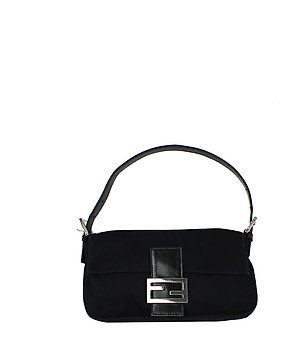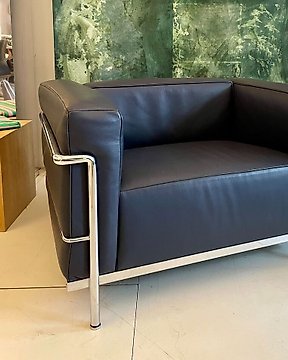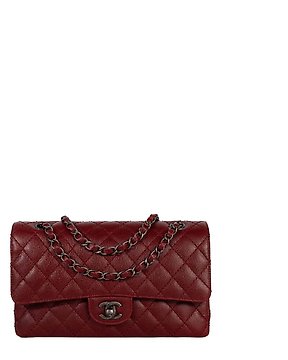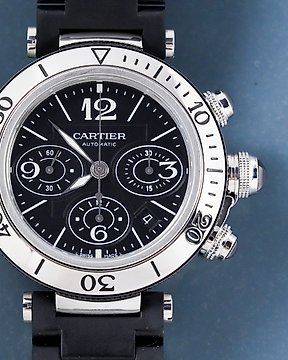Oldtidens Kina Terrakotta Udenlandsk rytter. 32 cm H. Tang-dynastiet, 618 - 907 A.D. Spansk importlicens.
Nr. 85411083

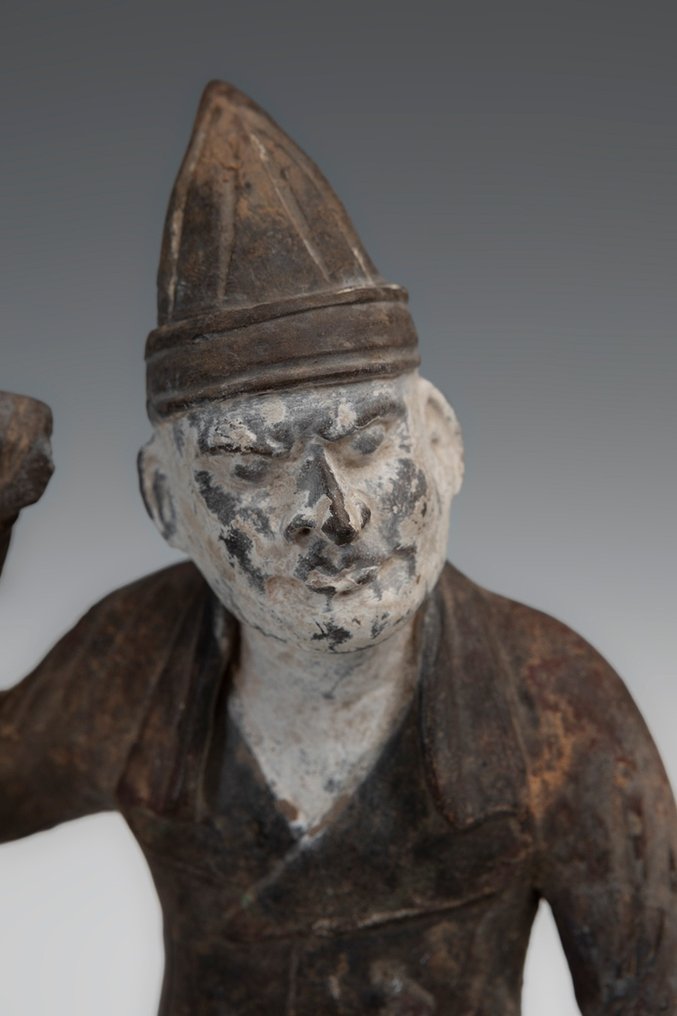
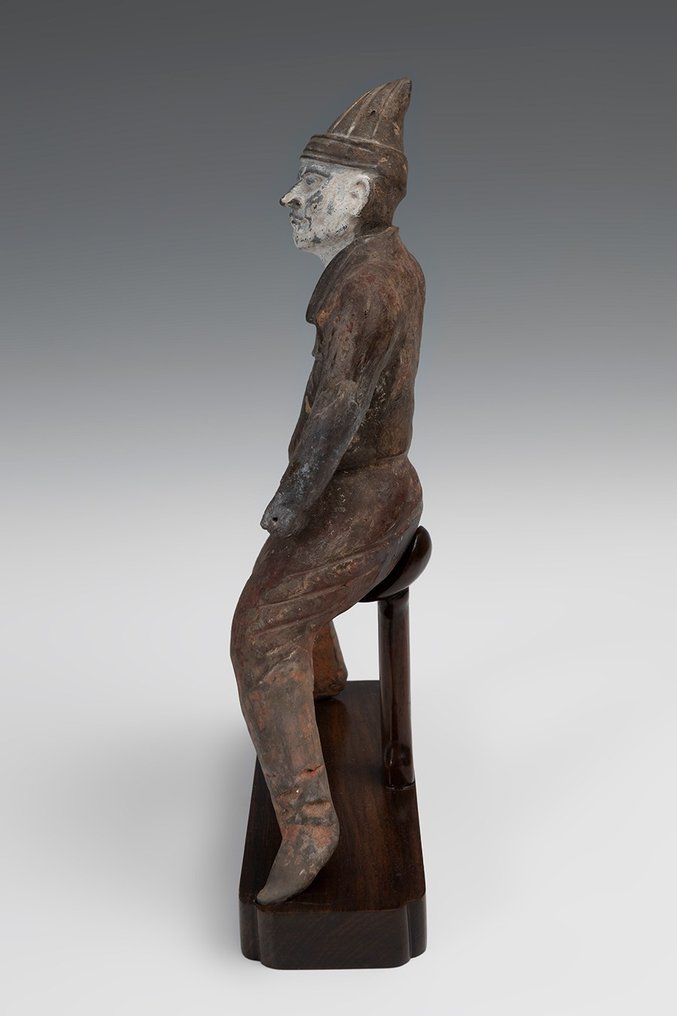
Foreign rider.
Chinese, Tang dynasty, 618 - 907 A.D
MATERIAL: Pottery and pigment
DIMENSIONS: 32 cm height
CONDITION: Good condition.
PROVENANCE: Private collection, Landshut, Germany, 1950.
Round sculpture made of terracotta and decorated with engobes in black and cream tones. It represents a foreign rider whose position evidences the movement and tension of the moment, with his right arm raised. He wears a suit with a jacket with collars and a pointed cap. His face evidences a violent and threatening attitude.
The Tang Dynasty was created on the 18th of June, 618 AD, when the Li family seized power from the last crumbling remnants of the preceding Sui Dynasty. This political and regal regime was long-lived, and lasted for almost 300 years. The imperial aspirations of the preceding periods and early Tang leaders led to unprecedented wealth, resulting in considerable socioeconomic stability, the development of trade networks and vast urbanisation for China’s exploding population (estimated at around 50 million people in the 8th century AD). The Tang rulers took cues from earlier periods, maintaining many of their administrative structures and systems intact. Even when dynastic and governmental institutions withdrew from management of the empire towards the end of the period – their authority undermined by localised rebellions and regional governors known as jiedushi –the systems were so well- established that they continued to operate regardless.
The artworks created during this era are among China’s greatest cultural achievements. It was the greatest age for Chinese poetry and painting, and sculpture also developed (although there was a notable decline in Buddhist sculptures following repression of the faith by pro-Taoism administrations later in the regime). It is disarming to note that the eventual decline of imperial power, followed by the official end of the dynasty on the 4th of June 907, hardly affected the great artistic turnover.
During the Tang Dynasty, restrictions were placed on the number of objects that could be included in tombs, an amount determined by an individual’s social rank. In spite of the limitations, a striking variety of tomb furnishings – known as mingqi – have been excavated. Entire retinues of ceramic figures – representing warriors, animals, entertainers, musicians, guardians and every other necessary category of assistant – were buried with the dead in order to provide for the afterlife. Warriors (lokapala) were put in place to defend the dead, while horses/ camels were provided for transport, and officials to run his estate in the hereafter. Of all the various types of mingqi, however, there are none more elegant or charming than the sculptures of sophisticated female courtiers, known – rather unfairly – as “fat ladies”. These wonderfully expressionistic sculptures represent the idealised beauty of Tang Dynasty China, while also demonstrating sculptural mastery in exaggerating characteristics for effect, and for sheer elegance of execution.
It is likely that the original purpose of the figure was that of a mingqi, terracotta figures designed to be included in a burial in order to accompany the deceased in the afterlife for protection, service and companionship.
They included daily utensils, musical instruments, weapons, armor, and intimate objects such as the deceased's cap, can and bamboo mat. Mingqi also could include figurines, spiritual representations rather than real people, of soldiers, servants, musicians, polo riders, houses, and horses. Extensive use of mingqi during certain periods may either have been an attempt to preserve the image of ritual propriety by cutting costs, or it may have a new idea separating the realm of the dead from that of the living.
Though these were particularly popular during the Tang dynasty (618-906 AD), mingqi from a broad range of historical periods have been found, with this piece acting as a particularly early example of the practice.
Notes:
The seller guarantees that he acquired this piece according to all national and international laws related to the ownership of cultural property. Provenance statement seen by Catawiki.
- The piece includes authenticity certificate.
- The piece includes Spanish Export License (Passport for European Union). NOT TAXES.
- According to Spanish legislation, items sent outside the European Union are subject to export taxes and will be added to the invoice, at the buyer's expense. These export fees are fixed on the final auction price and the tax rate is not applied directly on the total value of the item to be exported, but rather the different percentages by sections are applied to it:
- Up to 6,000 euros: 5%.
- From 6.001 to 60.000 euros: 10%.
This export permit application process can take between 1-2 months maximum.
THE MINISTRY OF CULTURE FROM SPAIN ASKS ALL SELLERS FOR INVOICES OR OTHER DOCUMENTATION ABLE TO PROVE THE LEGALITY OF EACH ITEM BEFORE PROVIDING AN IMPORT OR EXPORT LICENSE.
Sælger's Historie
Foreign rider.
Chinese, Tang dynasty, 618 - 907 A.D
MATERIAL: Pottery and pigment
DIMENSIONS: 32 cm height
CONDITION: Good condition.
PROVENANCE: Private collection, Landshut, Germany, 1950.
Round sculpture made of terracotta and decorated with engobes in black and cream tones. It represents a foreign rider whose position evidences the movement and tension of the moment, with his right arm raised. He wears a suit with a jacket with collars and a pointed cap. His face evidences a violent and threatening attitude.
The Tang Dynasty was created on the 18th of June, 618 AD, when the Li family seized power from the last crumbling remnants of the preceding Sui Dynasty. This political and regal regime was long-lived, and lasted for almost 300 years. The imperial aspirations of the preceding periods and early Tang leaders led to unprecedented wealth, resulting in considerable socioeconomic stability, the development of trade networks and vast urbanisation for China’s exploding population (estimated at around 50 million people in the 8th century AD). The Tang rulers took cues from earlier periods, maintaining many of their administrative structures and systems intact. Even when dynastic and governmental institutions withdrew from management of the empire towards the end of the period – their authority undermined by localised rebellions and regional governors known as jiedushi –the systems were so well- established that they continued to operate regardless.
The artworks created during this era are among China’s greatest cultural achievements. It was the greatest age for Chinese poetry and painting, and sculpture also developed (although there was a notable decline in Buddhist sculptures following repression of the faith by pro-Taoism administrations later in the regime). It is disarming to note that the eventual decline of imperial power, followed by the official end of the dynasty on the 4th of June 907, hardly affected the great artistic turnover.
During the Tang Dynasty, restrictions were placed on the number of objects that could be included in tombs, an amount determined by an individual’s social rank. In spite of the limitations, a striking variety of tomb furnishings – known as mingqi – have been excavated. Entire retinues of ceramic figures – representing warriors, animals, entertainers, musicians, guardians and every other necessary category of assistant – were buried with the dead in order to provide for the afterlife. Warriors (lokapala) were put in place to defend the dead, while horses/ camels were provided for transport, and officials to run his estate in the hereafter. Of all the various types of mingqi, however, there are none more elegant or charming than the sculptures of sophisticated female courtiers, known – rather unfairly – as “fat ladies”. These wonderfully expressionistic sculptures represent the idealised beauty of Tang Dynasty China, while also demonstrating sculptural mastery in exaggerating characteristics for effect, and for sheer elegance of execution.
It is likely that the original purpose of the figure was that of a mingqi, terracotta figures designed to be included in a burial in order to accompany the deceased in the afterlife for protection, service and companionship.
They included daily utensils, musical instruments, weapons, armor, and intimate objects such as the deceased's cap, can and bamboo mat. Mingqi also could include figurines, spiritual representations rather than real people, of soldiers, servants, musicians, polo riders, houses, and horses. Extensive use of mingqi during certain periods may either have been an attempt to preserve the image of ritual propriety by cutting costs, or it may have a new idea separating the realm of the dead from that of the living.
Though these were particularly popular during the Tang dynasty (618-906 AD), mingqi from a broad range of historical periods have been found, with this piece acting as a particularly early example of the practice.
Notes:
The seller guarantees that he acquired this piece according to all national and international laws related to the ownership of cultural property. Provenance statement seen by Catawiki.
- The piece includes authenticity certificate.
- The piece includes Spanish Export License (Passport for European Union). NOT TAXES.
- According to Spanish legislation, items sent outside the European Union are subject to export taxes and will be added to the invoice, at the buyer's expense. These export fees are fixed on the final auction price and the tax rate is not applied directly on the total value of the item to be exported, but rather the different percentages by sections are applied to it:
- Up to 6,000 euros: 5%.
- From 6.001 to 60.000 euros: 10%.
This export permit application process can take between 1-2 months maximum.
THE MINISTRY OF CULTURE FROM SPAIN ASKS ALL SELLERS FOR INVOICES OR OTHER DOCUMENTATION ABLE TO PROVE THE LEGALITY OF EACH ITEM BEFORE PROVIDING AN IMPORT OR EXPORT LICENSE.
Sælger's Historie
- 755
- 7
- 0
goede foto's, goede omschrijving, goed verpakt en snel verzonden.
Se oversættelsemolto bello tutto ok
Se oversættelsePezzo come da descrizione, davvero notevole. Venditore molto consigliato in quanto gentile e disponibile. spedizione molto veloce. Ottimo!
Se oversættelseVenditore davvero ottimo e gentile. Merce come da descrizione, spedizione veloce. Ottimo l'avere certificato di autenticità.
Se oversættelseUn 100 como empresa un 100 como envío . Empresa muy especial con mucha exquisitez en todos los productos y en personal . Muchas gracias
Se oversættelseAll well! Thanks.
Se oversættelseVery nice and fine cut little jewel! Well packed too! Thanks!
Se oversættelsenice piece and very fast shipping!
Se oversættelseEs una maravilla de moneda, donde se le nota los pasos de los años y me encanta. Servido muy rápido y bien empaquetado. Con su certificación. Qué más se puede pedir?
Se oversættelseSnelle en correcte levering, alleen was de verpakking voor het schilderij niet stevig genoeg.
Se oversættelseHerzlichen Dank!
Se oversættelseAll OK and with very fast shipping.
Se oversættelsePrachtig schilderij. Zo blij mee. Zeer nette verkoper en zeer snelle levering.
Se oversættelseperfect ! very fast and high quality delivery !
Se oversættelseAll well! Thanks.
Se oversættelseVendeur très professionnel, top +++×
Se oversættelsePhotos trop contrastées pour bien percevoir les défauts, mais ces défauts étaient visibles pour autant. Le "Bon état" est trompeur. Sinon, envoi rapide et correctement emballé. Frais de port exagérés.
Se oversættelseGreat communication, delivery and product. Came with a well made certificate of authenticity and good packaging. Overall very happy with the purchase! Delivery is a bit expensive, but I recommend it
Se oversættelseMagnifique témoin du passé, envoyé avec tous les justificatifs, impeccable. Encore une fois très satisfait, un grand merci
Se oversættelseThank you for the Special offer and the fast shipping of this excellent piece of art!
Se oversættelsevery good description of the object, very good price for this rare item,. Fast sending (has been at my place 2 days after buying!). Definitely would buy again.
Se oversættelseSehr schön
Se oversættelseAs described, perfect logistic
Se oversættelsegreat seller, everything came as should with certificate of authenticity
Se oversættelse- 755
- 7
- 0
Disclaimer
Sælger garanterer og kan bevise, at genstanden er erhvervet på lovlig vis. Sælger er blevet informeret af Catawiki om, at skulle fremskaffe den dokumentation, der kræves af love og regler i dennes bopælsland. Sælger garanterer at være berettiget til, at måtte sælge/eksportere denne genstand. Sælger sørger for, at al information vedrørende proveniensen af en genstand vil blive videregivet til køber. Sælger sørger for, at eventuelle nødvendige tilladelser er blevet eller vil blive indhentet. Sælger vil omgående informere køber om eventuelle forsinkelser i forbindelse med indhentelse af sådanne tilladelser.
Sælger garanterer og kan bevise, at genstanden er erhvervet på lovlig vis. Sælger er blevet informeret af Catawiki om, at skulle fremskaffe den dokumentation, der kræves af love og regler i dennes bopælsland. Sælger garanterer at være berettiget til, at måtte sælge/eksportere denne genstand. Sælger sørger for, at al information vedrørende proveniensen af en genstand vil blive videregivet til køber. Sælger sørger for, at eventuelle nødvendige tilladelser er blevet eller vil blive indhentet. Sælger vil omgående informere køber om eventuelle forsinkelser i forbindelse med indhentelse af sådanne tilladelser.

